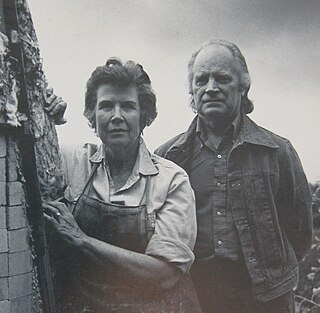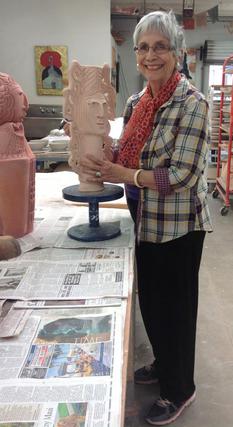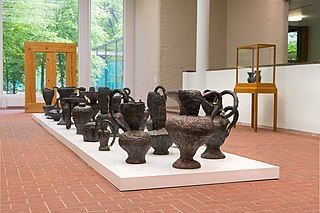Career

In the early 1960s, Frimkess went to Berkeley, California where Peter Voulkos was then teaching at the University of California, Berkeley. While there, he studied bronze and aluminum casting with Voulkos. [2] In 1963, his piece "Hooker No. 1" (a bronze sculpture of a television) was displayed at the San Francisco Art Institute's Annual exhibition at the San Francisco Museum of Modern Art. [9] Also that year at the behest of Voulkos, Frimkess took an internship at the Clay Art Center in Port Chester, New York. It was there that he met his future wife and frequent collaborator, Magdalena Suarez, who had come to the Art Center from Venezuela as part of a fellowship program. [2] While on the east coast, Frimkess was instructed to visit museums in New York and Boston to study Greek and Chinese forms of pottery. He also began learning the technique of "dry throwing" clay rather than using water. [6] [10] Much of his work after 1965 replicated classical forms like Greek volute kraters, Zuni pots, and Chinese ginger jars. [3] [11]
In 1966, his work was featured in the Abstract Expressionist Ceramics exhibition, which was displayed at several locations including in the art gallery of the University of California, Irvine and, later, the San Francisco Museum of Art. [12] [13] [14] In 1970, his work was featured alongside Robert Arneson, Ron Nagle, and David Gilhooly's in an exhibit at the Moore College of Art in Philadelphia, Pennsylvania. [15] In 1971, Frimkess was diagnosed with multiple sclerosis. His subsequent focus on rehab and physical therapy took time away from his ceramic work and limited his output. He continues to throw the pots, and his wife Magdalena Suarez Frimkess would glaze and decorate them. [2] [16]

In 1976, Frimkess' work was featured at the Clay: The Medium and the Method exhibition held at the art gallery of the University of California, Santa Barbara. A year later, his work was displayed at the Los Angeles Institute of Contemporary Art for their exhibition entitled Foundations in Clay. [17] The latter exhibition was considered an update of the Abstract Expressionist Ceramics exhibition from 1966 with five of the six artists returning, including Peter Voulkos, Ron Nagle, Kenneth Price, and John Mason. [18] That year, the James Willis Gallery in San Francisco also displayed a 17-year retrospective of Frimkess' work. [19] Another retrospective of his solo and collaborative work was held in 1982 at the Garth Clark Gallery in Los Angeles. [20]
By 1988, Frimkess' work could be found in the Smithsonian Institution, American Craft Museum, and the National Museum of Modern Art in Kyoto, Japan. That year, his work was also featured as part of an exhibition at the Fashion Institute of Technology called Extended Visions which displayed work from artists with multiple sclerosis. [21] In 2000, Frimkess and his wife held an exhibition of their work at Louis Stern Fine Arts entitled, Vessels of Satire: The Art of Magdalena and Michael Frimkess. In 2001, the two provided an official oral history of their lives and work to the Smithsonian Institution's Archives of American Art. [1] [2] In 2003, they displayed some of their work at Little Tokyo Clayworks in Los Angeles. [22] Beginning in 2012, their work started being displayed at South Willard, a menswear shop also in Los Angeles. [23] [24]
In 2013, some of Frimkess' early work was displayed at an exhibition called Grapevine at the David Kordansky Gallery in Culver City, California. [25] In March 2014, the Frimkesses' collaborative work was on display at White Columns in New York. [16] Their work was again featured at the Hammer Museum's biennial exhibition, Made in L.A. in August 2014. The couple was also honored with the Made in L.A. Mohn Career Achievement Award. [23] [26] In 2016, their work was featured at an exhibition called Routine Pleasures at the MAK Center in West Hollywood, California. [27]
In addition to exhibitions, Frimkess' work has appeared in numerous publications, including Ceramics Monthly , American Ceramics , and Craft Horizons magazines. In 1966 Frimkess wrote an article for Craft Horizons entitled, "The Importance of Being Classical," and he was later featured in its December 1973 issue ("Michael Frimkess and the Cultured Pot"). [1] More recently, Michael and Magdalena have been profiled in both the Los Angeles Times and the New York Times. [2]













